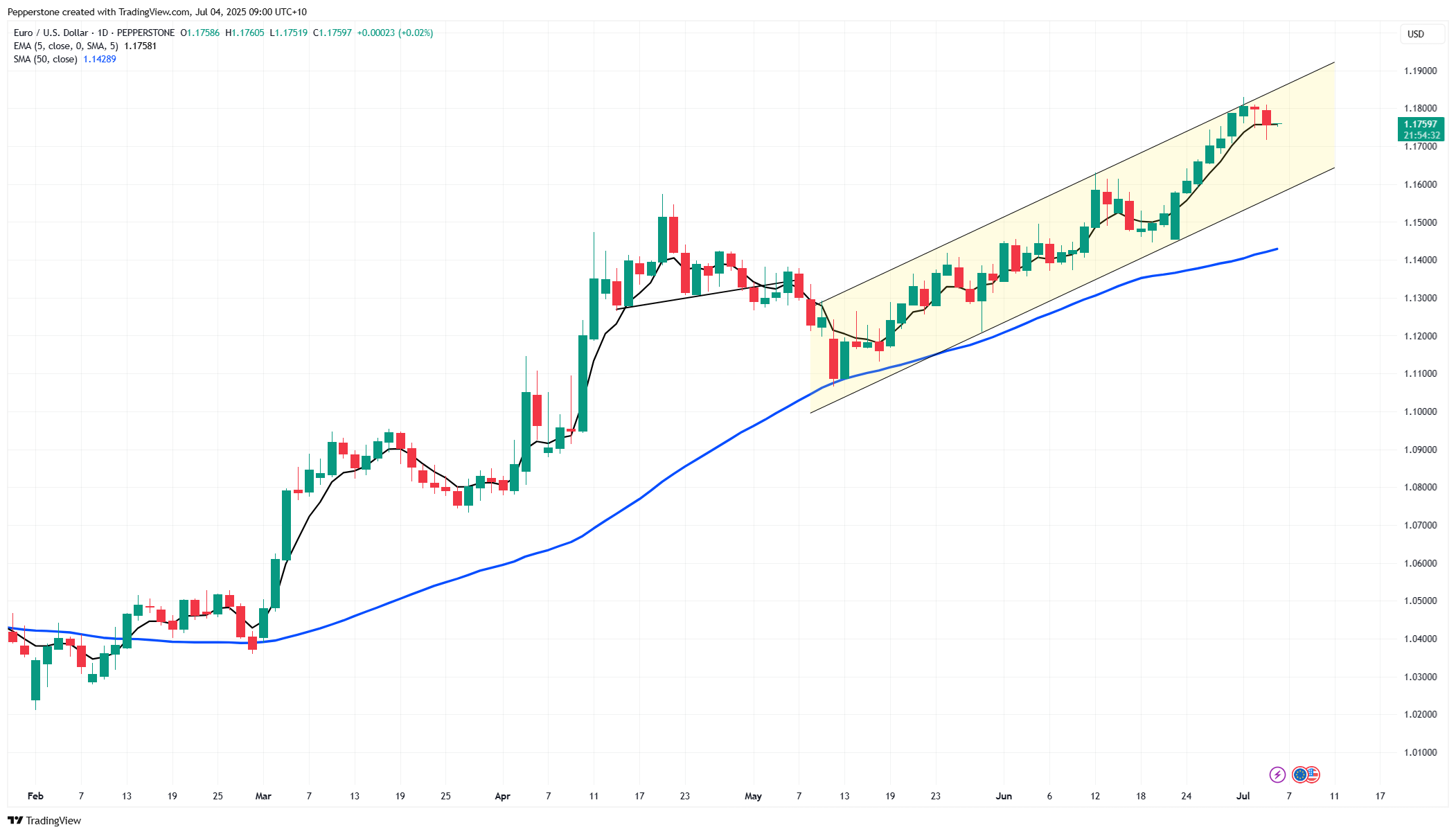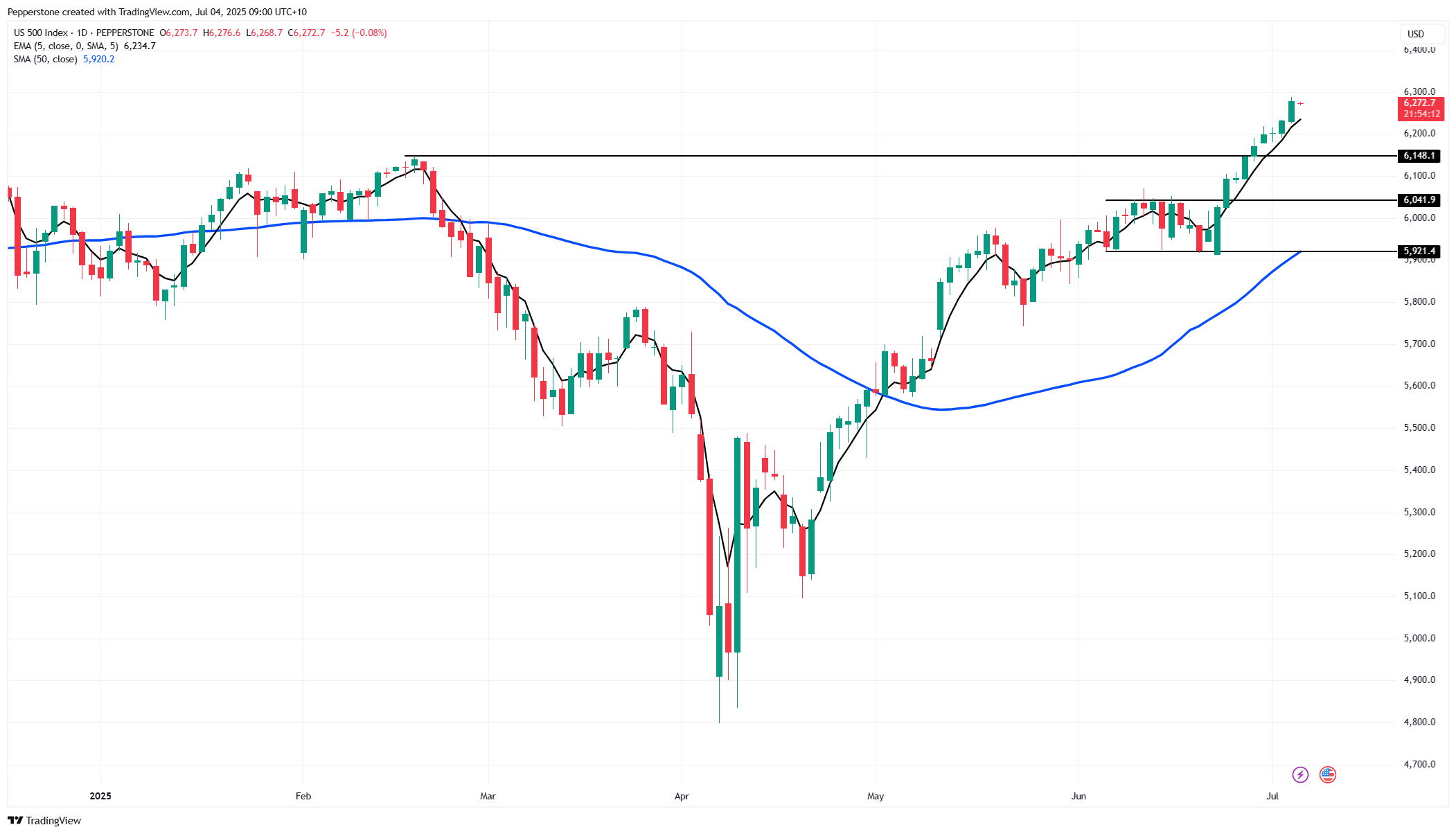- English (UK)
US Risk Appetite Surges as OBBBA Clears Congress and S&P500 Hits New High

The US NFP release has now been well sliced and diced, and while markets put weight to the headline jobs print and the U/E rate – all of which have met the goldilocks scenario – those that scratch below the surface can point a soft level of private payrolls growth (+74k jobs), with the robust growth seen in government hiring, a factor that is unlikely to persist in the following NFP reports (due 1 August and 5 Sept).
The lower US participation rate has also been a focal point, and the key factor that has taken the U/E rate to 4.1% - however, aggregating the outcome from the NFP release, and marrying to the lower initial claims and modestly better ISM Services report (50.8 vs 50.5 eyed), we see US interest rate swaps lowering the implied probability for a 25bp cut in the July FOMC meeting to 5%, with a cut in September now seen at a 67% probability (from a 95% implied).

US 2-yr Treasury yields settled up 10bp to 3.87%, with UST 10s +7bp 4.34%, with the US 10yr real rate +4bp at 1.99%. US cash Treasury and T-bill markets were closed when headlines rolled in that Congress had passed the One Big Beautiful Bill Act (OBBBA), but Treasury futures were open and saw little reaction, with the USD also unmoved on the developments – perhaps a function of the reduced participation, with traders closing their books and calling it a week in the markets – but perhaps this outcome was already ascribed a higher probability and thus discounted.
One can debate the merits of whether the OBBBA is indeed priced, I am skeptical on that, as this is such an incredibly large piece of legislation that will not truly manifest in the US economy until 2026, that we really need to observe the long end of the Treasury curve and any observable rise to term premium to make a clear call here.
With the OBBBA also lifting the debt ceiling by $5 trillion, the removal of the risk that the Treasury Department would exhaust the capacity to fund itself is a highly welcome development for all market players, and the Treasury Department will soon look to ramp up bill issuance and to rebuild the TGA. Whether that has any noticeable effect on cross-asset liquidity that increases risk to equity markets is yet to be seen, but the passing of the OBBBA avoids a headache that few wanted to go through.
One also has to be impressed at Trump and speaker Johnson’s ability to pass this reconciliation bill through Congress with such ease – what deals were made behind closed doors we may never know, but it's hard to recall any other Republican president being able to pass such a contentious fiscal program on such a slim majority – perhaps this efficient functionality to pass legislation will evolve past the mid-terms, but it is certainly very impressive.

The debate around the ongoing trajectory of the USD intensifies, where in the day the USD has seen shorts part cover, and the momentum in the USD selling has clearly abated. The OBBBA will increase the US deficit, but with the bill also set to support US growth and with tariffs already having a sizeable effect on customs & excise revenue, perhaps the impact on the deficit and the expected level of bill/bond issuance to fund will not be as dramatic as some suggest.
Taking a stance that the world is not giving up on investing in the US capital markets, one can therefore start to see a more constructive investment case for the USD in 2026. Positioning for 2026 is perhaps best left to bond investors or those entering into USD forward agreements, but it is an eternity for the more speculative fractions in the market. Still, it is a consideration that will get more airtime as we roll deeper into Q325 and whether the USD will hold a far more attractive investment case in 2026.
With US swaps implying a base case of two 25bp of cuts from the Fed by December – Perhaps the more pertinent near-term consideration for the USD traders is whether the Fed are more likely to cut rates once or three times in 2025, and if they were to cut just once, would that be driven by improved growth dynamics or due to hotter inflation risk.

US equity saw the headline data releases as good enough to keep the bullish momentum in check. S&P500 futures were already accelerating into the NFP report, and those positioned for the headline outcome saw futures trade to new highs of 6333. The S&P500 cash index saw all sectors except materials closing in the green, with tech and financials once again the sectors that have pulled the index higher.
US equity move into a more euphoric state, but the melt-up is absolutely real – pullbacks should be shallow and well supported, but there’s no doubt that buying into risk at these levels is not overly appealing but until we see something that throws real conjecture into the goldilocks/nirvana backdrop, the chase and the need to outperform remains the play.
Good luck to all.
The material provided here has not been prepared in accordance with legal requirements designed to promote the independence of investment research and as such is considered to be a marketing communication. Whilst it is not subject to any prohibition on dealing ahead of the dissemination of investment research we will not seek to take any advantage before providing it to our clients.
Pepperstone doesn’t represent that the material provided here is accurate, current or complete, and therefore shouldn’t be relied upon as such. The information, whether from a third party or not, isn’t to be considered as a recommendation; or an offer to buy or sell; or the solicitation of an offer to buy or sell any security, financial product or instrument; or to participate in any particular trading strategy. It does not take into account readers’ financial situation or investment objectives. We advise any readers of this content to seek their own advice. Without the approval of Pepperstone, reproduction or redistribution of this information isn’t permitted.